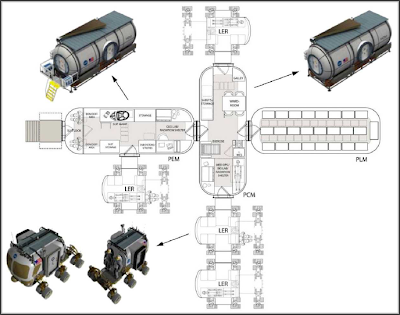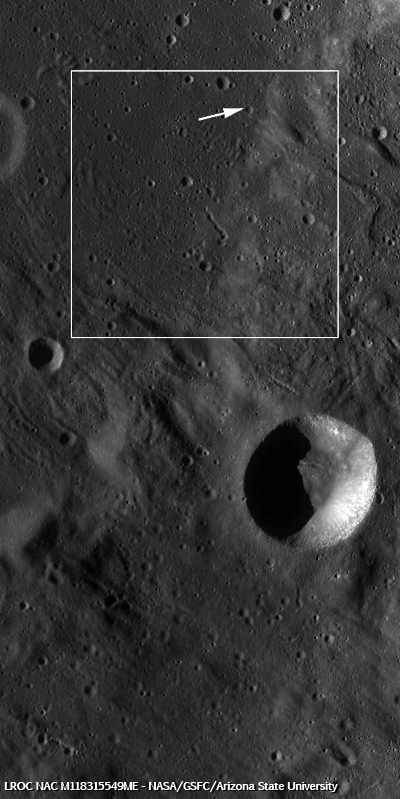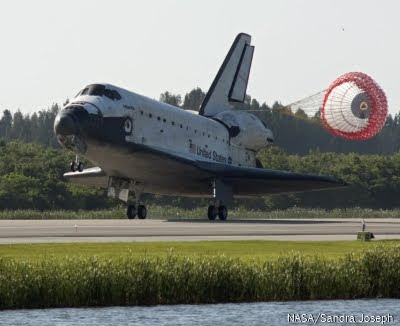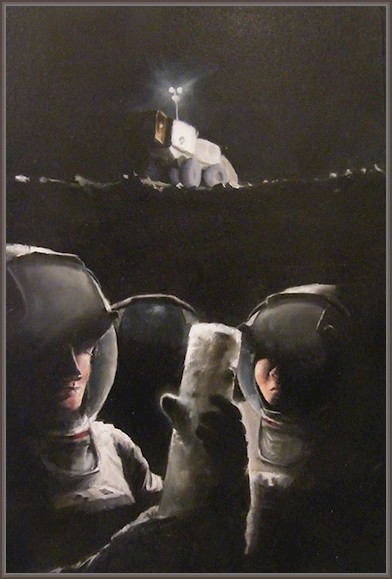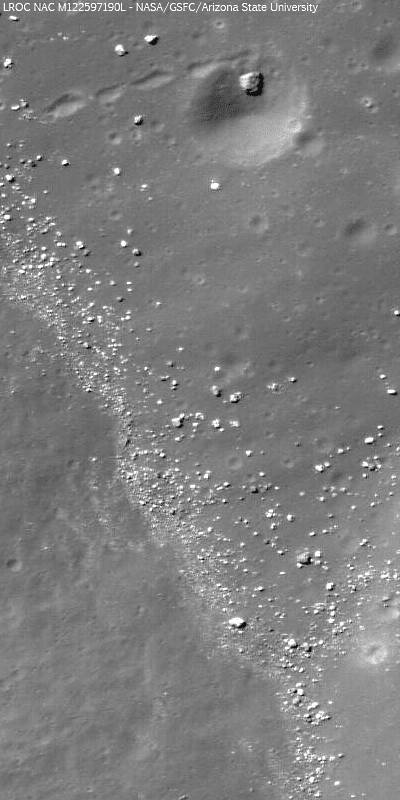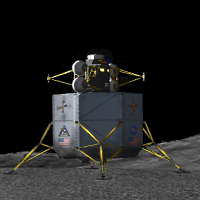Interior of fresh impact crater in the Smythii Constellation Region of Interest. Portion of image M126371530LE, full scene width = 530 meters [NASA/GSFC/Arizona State University].
Brett DeneviLROC News System
The
featured image shows the interior of a fresh impact crater (approximately 300 meters in diameter) within the Mare Smythii Constellation Region of Interest (ROI).
The high-sun image (set atop a closer, full-sized look at the dark, fractured melt on the crater floor) above, it's hard to recognize topographic features because there are no shadows. Wider views following below are paired with lower-sun images of this same crater (on the right, in the thumbnail, which is then followed by cropped vertical comparisons from the
full sized image) give sharper views of small scale features, such as boulders.
A wider view of the same fresh crater under high-sun (above, LROC M126371530LE, solar incidence, Sun-Moon-LRO phase angle = 21°) and lower sun image, with illumination from the east (below, LROC M113392375LE, solar incidence phase angle of 50°) [NASA/GSFC/Arizona State University].
The floor of this small crater looks like a basket of impact-melt covered rocks. Sampling the ejecta would help answer questions about the age of apparently recent impacts such as this one and the processes that cause their fresh rays to fade.
LROC Wide-Angle Camera (WAC) context image of the Mare Smythii Constellation Region of Interest (40 x 40 kilometer box centered on the area), including the eastern portion of 31 kilometer wide Schubert C (1.8°N, 84.6°). The arrow indicates the location of the fresh crater highlighted as the Featured image, above. LROC WAC M115753790CE, LRO orbit 2192, spacecraft altitude 41.21 km., December 18, 2009 [NASA/GSFC/Arizona State University]. Mare Smythii is located on the eastern limb of the Moon and would provide an excellent place to sample relatively young (1-2 billion years old) basaltic lavas not represented among previously collected samples. The western portion of the Region of Interest encompasses the crater Schubert C, the floor of which is fractured, possibly due to intrusions of met from beneath its surface - a great hypothesis for future explorers to assess.
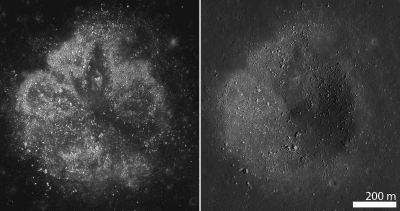

As the terminator sweeps westward relief that highlights elevation with long shadows gradually gives way to a high-sun near the equator, and a different very appearance for the same feature. Farther above is a thumbnail side by side comparison showing low and high illumination of an older south of the one highlighted in the LROC Featured Image. Comparison of conditions May 4, 2010 (when LROC Narrow-Angle Camera M126371530LE was imaged earlier in the local lunar day) is made with November 20, 2009., when LROC NAC M113392375LE was swept up. Under more typical illumination slumps of material and large boulders are revealed as the source of the high and low albedo [NASA/GSFC/Arizona State University].
Ed Note: Mr. Denevi also recommends, and we strongly concur, those interested should read more about Smythii Basin in the explanation given for an excellent orbital frame from Apollo 15 (AS15-M-0792),
Image of the Week, February 5, 2008, from the Apollo Image Archive also maintained by Arizona State University.
Charles A. Wood, steadfast archivist of the Lunar Picture of the Day (
LPOD) website, highlighted an excellent earthside image of the area of the Smythii Basin Constellation ROI, taken by Bart Declercq of Zottgem, Belgium and published as the
LPOD on February 25, 2008. In addition to Charles' keen and educated discussion, the image there is a very good illustration of Smythii Basin in relation to Earth-bound observers.
When Mr. Denevi says this area is on the "eastern limb of the Moon," you can see
here that's precisely what he means!
The Smythii basin itself, despite the aforementioned, "relatively recent" inundation, is actually dated to the Pre-Imbrium, or older than the "basin-forming impact event" that created Mare Imbrium. Like the Moon itself Smythii Basin is also a time capsule, carrying in its features a very well preserved history of the Moon and that of both the Solar System and that part of the Solar System occupied by Earth.
Thus, Smythii Basin records magnitude, frequency and the characteristics of a long history of conditions at the same "point in space" where the Earth is that unavailable anywhere else. Once again, "
to study Earth's Moon is to study Earth itself."
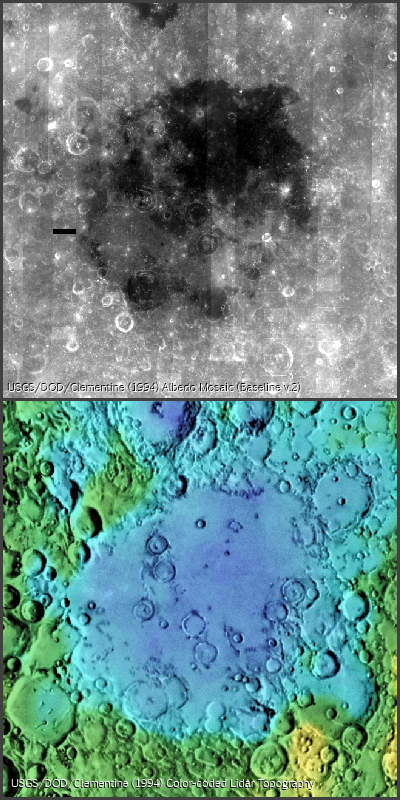
From the United State Geology Service (Astrogeology Program) ever-improving and invaluable "Map-a-Planet" website, two views of Mare Smythii from very different remote sensing. Above is Clementine (1994) Baseline Albedo (v.2) compared below with color-coded lidar topography, in false-color. This demonstrates well yet another way in which the eye is often aided or prevented often from seeing features that might be obvious to blind laser pulse timing, and vice versa [USGS/DOD/NASA].
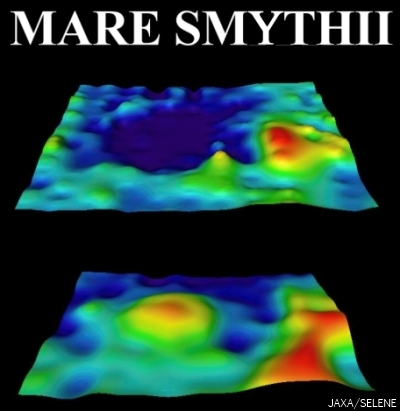
How about an "anti-MASCON? Highlights from Japan's first lunar orbiter Kaguya (SELENE-1, 2007-2009) were global surveys of the Moon's complex gravity, down to as yet unmatched resolution. Above is Kaguya's simple false color surface elevations, presented in a the form of Smythii Basin in cross-section. Below that, in the very center of the ancient basin, we find the opposite of the kind of mass concentration, or "MASCON" we've long been accustomed to within basins like Mare Imbrium, for example. Standing on the rim of the Imbrium Basin, for example, while holding out a standard carpenter's plum bob on a string, the weight would very visibly hang at an angle toward the direction of the wide-basin's center. Smythii on the other hand appears to host the opposite an "anti-MASCON," or a local mass density lower than the global average, also at the basin's center (and equally invisible from above). [JAXA/SELENE].

